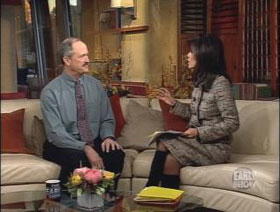  |
| HOME | THIS ISSUE | CALENDAR | GRANTS | BACK ISSUES | < BACK | NEXT > |
Researcher becomes spokesperson on night shifts and cancer by Chris DeFrancesco - January 28, 2008 | ||||
| Richard Stevens, a cancer epidemiologist at the UConn Health Center, has been theorizing about a link between artificial light and breast cancer since the mid-1980s. Now, it seems, the scientific community may finally be ready to listen. Last fall, the International Agency for Research on Cancer (IARC), part of the World Health Organization, decided to classify shift work as a “probable human carcinogen,” a designation also given to agents such as diesel emissions and ultraviolet radiation. By some estimates, as much as 20 percent of the workforce in developed countries is on a night shift. “It was interesting to have been involved in this area for so long and have it way under the radar screen,” Stevens says. “Now, with this classification by the IARC, it’s not an oddity, it’s mainstream.” In the past two months, this cancer research milestone – which was published in the Lancet Oncology, a British journal comparable in prestige to the Journal of the American Medical Association – has become world news. International panel The group recommended a Group 2A classification, one step down from the status of “proven carcinogen,” reserved for things like tobacco and asbestos. “The 2A classification is taken very seriously by OSHA, the EPA, and the FDA,” Stevens says, “so it will probably have some implications for regulation. But those agencies are really going to watch this field now, because there’s a lot more coming out.” Stevens is one of many contributors to the work that led to the IARC’s declaration on shift work, which has to do with the disruption of the body’s circadian rhythm and therefore the production of hormones that affect breast cancer risk. “But there’s potentially much more to it biologically than that,” he says. “If we become sure that it is shift work, that it’s the lighting that’s changing these hormones, then we need to figure out the actual mechanism: What kind of light, what time of the night, what’s doing it? Once we figure that out, then we might be able to implement effective intervention.”
Communicating research In October, after talking to a Washington Post reporter about the end of Daylight Savings Time, Stevens thought the conversation about the impact of longer nights was missing something. After consulting with the head of the IARC Carcinogen Identification and Evaluation Group, Stevens told the reporter about the upcoming study on shift work. Its mention in the Washington Post story drew the interest of the Associated Press in London, which ran a story just before the Dec. 1 publication date for the Lancet Oncology article. The story was picked up by hundreds of media outlets, from Connecticut to Russia. Stevens appeared live on CBS and Fox News, and did nearly a dozen local television, newspaper, and radio interviews. Stevens, a professor at the UConn School of Medicine, says although working with the media can be time-consuming, he regards helping reporters as his obligation as a scientist: “If you don’t answer the reporter’s questions, you can be sure he’ll move on until he finds someone who will, someone who may not be as qualified as you, and that would be a disservice to the science.” Dr. Carolyn Runowicz, director of the Carole and Ray Neag Comprehensive Cancer Center at the UConn Health Center, says, “The public pays for a significant part of research through donations to foundations, philanthropy, and taxes, which ultimately fund grants from the National Institutes of Health. Talking to reporters, and in doing so, educating the public, gives us a chance to show the return on that investment, and with that comes the potential for additional funding to advance the science.” Says Dr. Lawrence Raisz, director of the UConn Center for Osteoporosis, “Any time you have a chance to explain your work and have it recognized by laypersons, you should do so, under any circumstances, with any size audience. You should promote your work by realistic statements and in understandable terms.” Adds Stevens, “When a reporter calls, it’s not a nuisance but an opportunity.” |
| ADVANCE HOME UCONN HOME |

